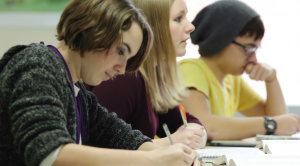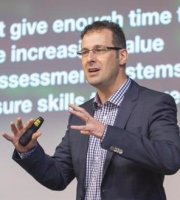 On the heels of my previous post about why some teachers fail to realise the efficiency gains of technology, Today I had a conversation with a teenager that went like this:
On the heels of my previous post about why some teachers fail to realise the efficiency gains of technology, Today I had a conversation with a teenager that went like this:
Student: “My teachers won’t let me take a photo of the whiteboard with my iPad.”
Me: “Are you telling me, they make you copy off the whiteboard with pen and paper?”
Student: “Yes”
Me: “How many of your teachers do this?”
Student: “All of them!”
Me: “Are you serious?”
Student: “They tell us that copying the board will help us remember and understand the information better”
Me: “And do you think it does?”
Student: “No, I’m usually not even thinking about what I’m writing; I’m just copying down the words”
I don’t buy for a moment that students will remember or understand information significantly better by copying! Telling that to students is as disingenuous as it is absurd! When I read the morning newspaper I don’t need to copy out the news stories in order to comprehend them! When researching a topic of interest I read relevant articles, maybe make a few notes and save them to Evernote for future reference but I don’t transcribe the articles in full onto loose leaf! What makes anyone think that copying paragraphs of text from the board will make students remember or understand? As you began reading this blog post, did the thought even cross your mind to start copying it out with pen and paper to aid your understanding? Of course it didn’t! That would be a prodigious waste of your time and would make little to no difference to your comprehension.
Let’s be honest. The real reasons teachers make students copy information from the board are:
(a) It pads out the lesson with busywork, so a very small amount of learning will use up an entire period (It reduces the teacher’s preparation time : class time ratio).
(b) It is the easiest way to “wing it” when a teacher hasn’t prepared a genuine and engaging learning activity.
(c) It keeps students seated, quiet and under control.
In 1989 copying information from the board was a practical way for students to collect a body of examinable subject knowledge to learn (i.e. memorise / encode), because schools didn’t have photocopiers, students didn’t have cameras, and nobody had Google.
In 2015, valid reasons for using a whiteboard might include sketching a diagram to answer an extemporaneous student question, teaching basic literacy skills (character formation, perhaps spelling) or to capture a group brainstorming session. A whiteboard is useful for that kind of thing. (And don’t be ridiculous – if your students have smartphones, let them take a photo, if it helps them!). But I can’t think of any good reason for entering class, with the intention of writing screeds of informational text on the board for students to copy like it were still 1989.
It’s a squandering of class time – a great example of wheeling technology, instead of riding it (to borrow the metaphor from my previous post).




You must be logged in to post a comment.